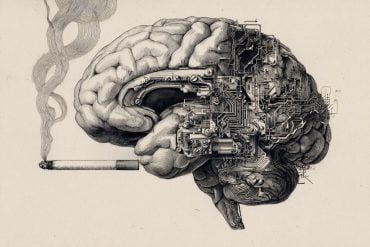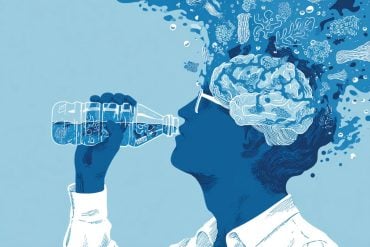Summary: Non-invasive brain stimulation, such as rTMS, helps to reduce smoking frequency in nicotine-dependent people, a new study reports. Stimulating the dorsolateral prefrontal cortex with repetitive transcranial magnetic stimulation significantly reduced smoking frequency.
Source: Society for the Study of Addiction
A new systematic review of randomized controlled trials has found evidence that non-invasive brain stimulation may reduce smoking frequency (number of cigarettes per day) in nicotine-dependent smokers.
Because nicotine can produce neuroadaptations in the brain that makes it hard to quit smoking, researchers have sought ways to treat nicotine dependence with non-invasive brain stimulation (NIBS) techniques that counteract abnormal brain activity associated with chronic nicotine exposure.
This review, published by the scientific journal Addiction, looked at twelve randomised controlled trials of NIBS methods on a combined total of 710 participants with nicotine dependence. It used a network meta-analysis technique to compare the benefits and safety of various types of NIBS.
Several NIBS techniques showed promising results, but the best results came from high-frequency repetitive transcranial magnetic stimulation (rTMS) of the left dorsolateral prefrontal cortex (DLPFC), which was associated with the greatest reduction in smoking frequency.

Interestingly, none of the investigated NIBS appeared to reduce the severity of either craving or nicotine dependence, compared with the control groups. It may be that enhancement of DLPFC activity increases dopamine release, counterbalances the reward system, and helps patients cope with unaffected craving and withdrawal symptoms.
None of the investigated NIBS was associated with dropout rates significantly different from those of the control groups, suggesting that these kinds of treatments are well-tolerated.
Nicotine affects the release of neurotransmitters in the brain, increasing brain activity and the release of dopamine. Higher levels of dopamine bring pleasure to the smoker. Over time, chronic nicotine exposure causes the brain to produce more receptors to handle the increased brain activity.
When nicotine levels drop, such as when a smoker tries to quit, activity in the brain’s reward system decreases, causing withdrawal symptoms that encourage continued smoking.
About this addiction and brain stimulation research news
Source: Society for the Study of Addiction
Contact: Jean O’Reilly – Society for the Study of Addiction
Image: The image is in the public domain
Original Research: Open access.
“Efficacy of non-invasive brain stimulation interventions in reducing smoking frequency in patients with nicotine dependence: a systematic review and network meta-analysis of randomized controlled trials” by Tseng P-T, Jengd J-S, Zenge B-S, Stubbs B, Carhalho AF, Brunoni AR, Su K-P, Tu Y-K, Wu Y-C, Chen T-Y, Lin P-Y, Liang C-S, Hsu C-W, Chen Y-W, and Li C-T. Addiction
Abstract
Efficacy of non-invasive brain stimulation interventions in reducing smoking frequency in patients with nicotine dependence: a systematic review and network meta-analysis of randomized controlled trials
Background and aims
Nicotine is a highly addictive substance in tobacco products that dysregulates several neurotransmitters in the brain and impairs executive function. Non-invasive brain stimulation (NIBS) methods such as repetitive transcranial magnetic stimulation (rTMS) and transcranial direct current stimulation (tDCS) are promising treatments for nicotine dependence. We investigated the efficacy and acceptability of NIBS in managing smoking cessation through a systematic review and network meta-analysis (NMA).
Methods
We conducted a systematic review to identify randomized controlled trials (RCTs) that investigated the efficacy of NIBS for smoking cessation. All pairwise meta-analyses and NMA procedures were conducted using random-effects and frequentist models. The co-primary outcomes were (1) the change in number of cigarettes smoked per day (change in frequency of smoking) in patients with nicotine dependence after NIBS and (2) acceptability (the dropout rate). The effect sizes for co-primary outcomes of change in frequency of smoking and acceptability were assessed according to standardized mean difference (SMD) and odds ratio, respectively.
Results
Twelve RCTs with 710 participants (mean age: 44.2 years, 31.2% female) were included. Compared with the sham control, 10-Hz rTMS over the left dorsolateral prefrontal cortex (DLPFC) was associated with the largest changes in smoking frequency [SMD = −1.22, 95% confidence interval (95% CI) = −1.77 to −0.66]. The 2-mA bifrontal tDCS (SMD = −0.97, 95% CI = −1.32 to −0.62) and 10-Hz deep rTMS over the bilateral DLPFC with cue provocation (SMD = −0.77, 95% CI = −1.20 to −0.34) were associated with a significantly larger decrease in smoking frequency versus the sham. None of the investigated NIBSs was associated with dropout rates significantly different from those of the sham control groups.
Conclusion
Prefrontal non-invasive brain stimulation interventions appear to reduce the number of cigarettes smoked with good acceptability.






